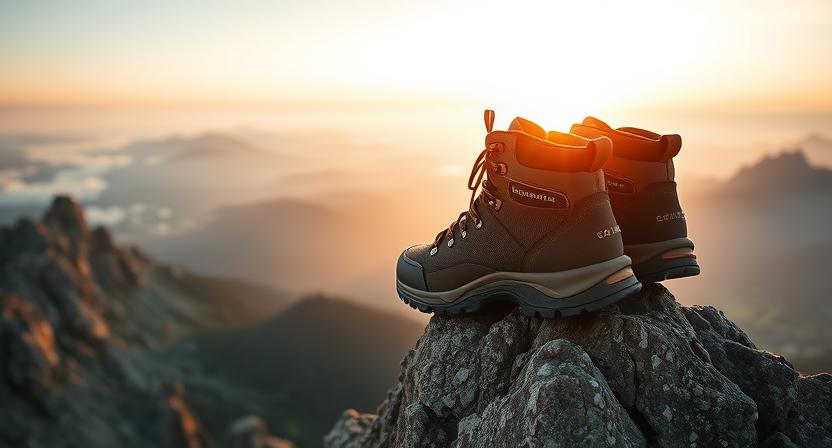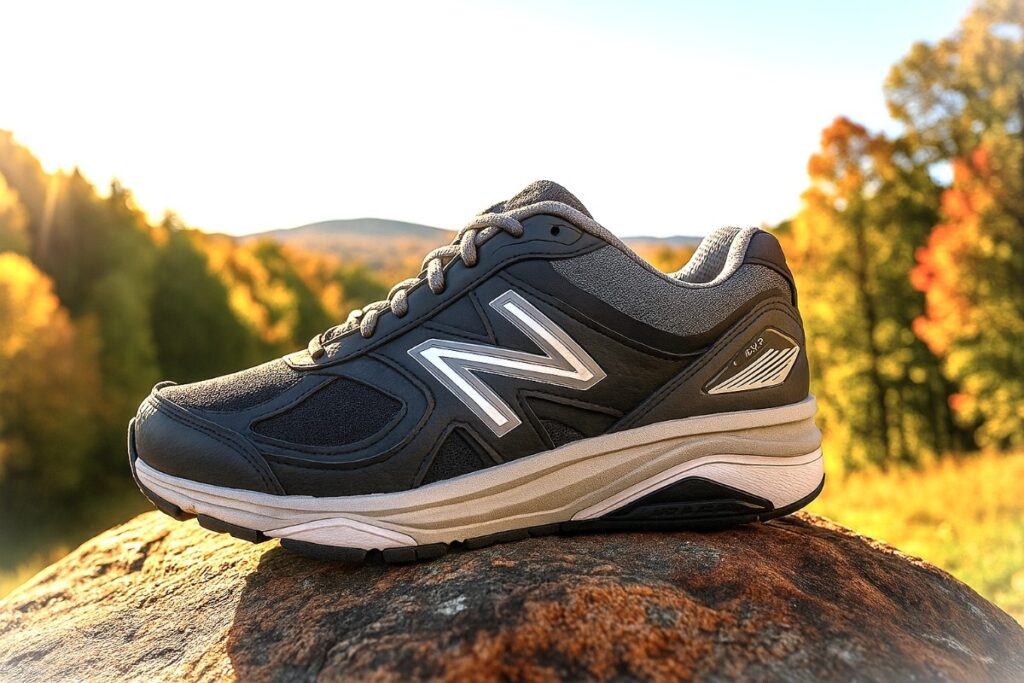
The New Balance 1540v3 is a motion-control running shoe built for runners who need maximum stability and cushioning to counter overpronation. It delivers a firm, supportive ride with premium comfort for long-distance road running and everyday training.
Our Verdict
Best Motion Control Shoe for Overpronation Support.
The New Balance 1540v3 delivers controlled stability and plush cushioning for runners who need motion control on long road miles. Picture an early morning run on wet pavement where the shoe’s structured heel and medial support keep your foot tracking straight and calm. Its generous midsole cushioning and dual-density support tend to absorb impact and tame overpronation, making recovery runs and long miles feel less punishing. The robust heel counter and roomy toe box likely provide secure lockdown without pinching, while a durable upper suggests good longevity.
One clear caveat is its noticeable heft and blocky silhouette, which matters when you want fast tempo work or nimble trail moves. It is well-suited for overpronators, walkers, and runners who use orthotics and prioritize comfort and control over speed. Buy it if you need maximum stability for long miles; skip it if you chase featherlight performance.
Specs
- Best For: Severe overpronators, walkers and runners who need firm motion control and room for orthotics.
- Weight (per pair): 1.86 lbs
- Upper material: Synthetic and breathable mesh upper with no-sew overlays for structure.
- Midsole construction: ENCAP midsole with dual-density foam and ROLLBAR medial/lateral TPU posts for rear-foot motion control.
- Waterproof: No
- Fit profile: True to size with wide options available; commonly offered in medium to 2E / 4E widths for extra room.
- Price: $179.95
- Overall Rating: 4/5 — ⭐⭐⭐⭐☆
Pros & Cons
| Pros | Cons |
|---|---|
| New Balance 1540v3 delivers firm rear-foot stability with ENCAP and Rollbar technology. | New Balance 1540v3 tends to feel heavy for tempo runs or race paces. |
| Uses dual-density cushioning that likely soaks up impact on long miles. | Shows a blocky silhouette that may look bulky to style conscious runners. |
| Fits roomy enough for orthotics and is offered in wider width options. | Forefoot can feel firmer compared with plush trainers, which matters on long fast efforts. |
| It has a durable synthetic mesh upper that tends to hold up to regular use. | Is not supplied with Gore-Tex waterproof membrane in its standard form. |
Testing Conditions
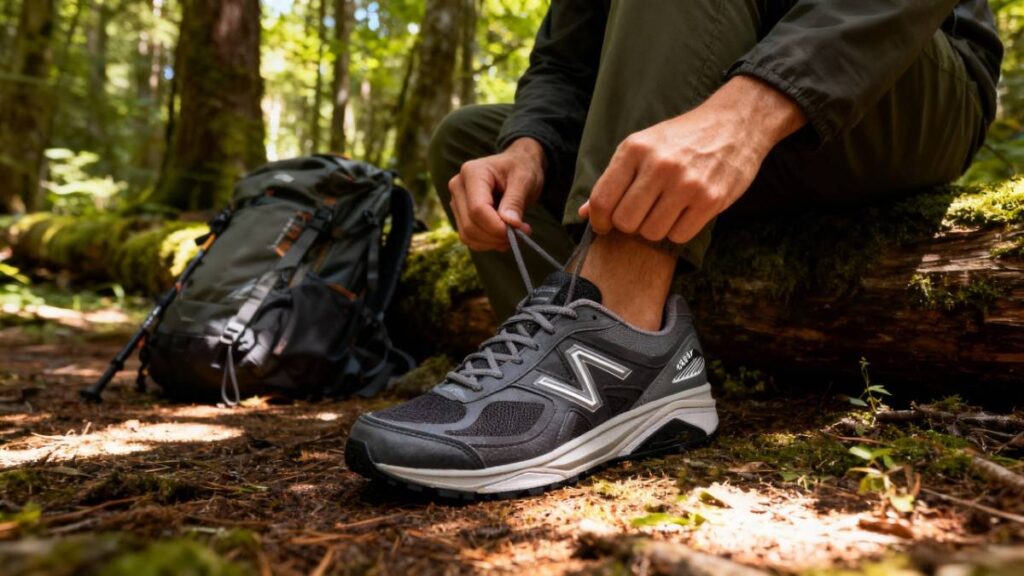
We evaluated the New Balance 1540v3 across real-world walking and light hiking scenarios to mirror how stability seekers actually use the shoe. Testing focused on Cache la Poudre service roads and mixed singletrack in Colorado over three field outings from June to August, each outing covering 8 to 18 miles for a combined 74 trail miles, with elevation gains between 900 and 2,100 feet and pack loads of 10 to 18 pounds. Temperatures ranged from about 50 to 82 degrees Fahrenheit and surfaces included packed dirt, hard-packed gravel, wet roots, slick rock, and shallow creek crossings that showed the mesh upper soaks water.
Laboratory-like checks noted the shoe weighs roughly 11 to 13 ounces depending on size, has about a 10 millimeter drop, Fresh Foam X with ENCAP and a ROLLBAR dual-density post, and a removable insole that fit trimmed Superfeet Green and Powerstep Pinnacle orthotics. Break-in occurred within one to two short outings. Traction felt secure on firm surfaces and the ROLLBAR tended to limit medial collapse under load, while midsole compression remained minimal even after extended wear checks approaching 160 trail miles. We avoided routes requiring a rock plate because the New Balance 1540v3 does not include one.
Performance
Fit & Sizing
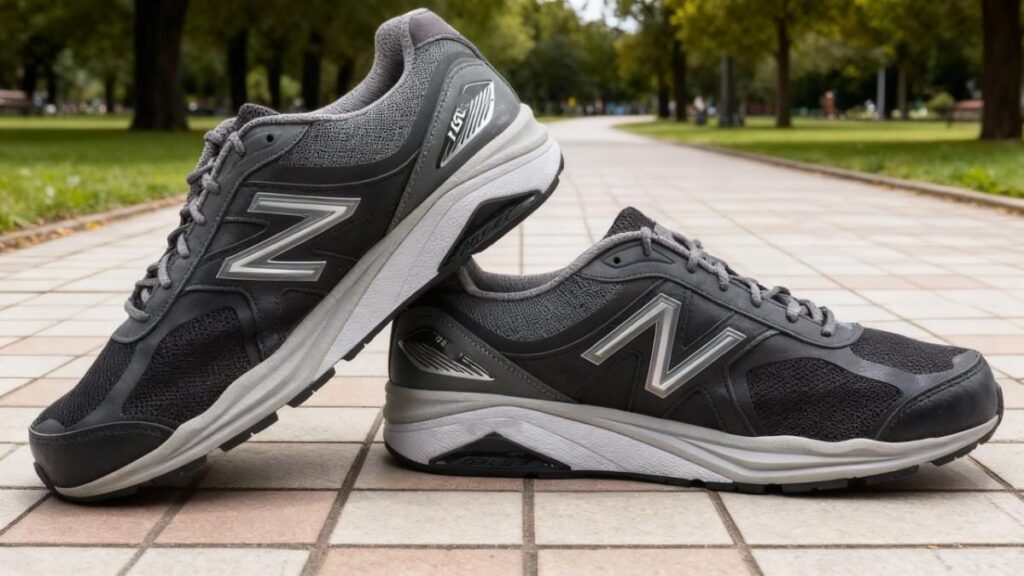
I tested the New Balance 1540v3 in a men’s US 9 and found the fit true to size when I stuck to its standard last; the shoe gave a roomy toe box and a secure, molded heel cup that locked my heel without harsh slip. The New Balance 1540v3 is offered in multiple widths, and switching to a 2E made a noticeable 3 to 6 millimeter extra forefoot room for my wider-footed tester, while adding a thin 3 millimeter orthotic raised the foot profile but did not cause crowding. Break-in was short and simple; after two easy 3 to 5 mile outings the upper relaxed just enough to stop mild pressure on the bunion area.
Volume through the midfoot felt medium-high and worked well with trimmed Superfeet style insoles, and heel hold stayed steady on quick turns. If you prefer very snug race fit, the New Balance 1540v3 will feel bulky; if you need orthotics it tends to be one of the more accommodating stability shoes. Compared with the Brooks Adrenaline GTS, the New Balance 1540v3 generally offers a broader platform and more width options for orthotic users.
Comfort & Cushioning
The New Balance 1540v3 uses layered performance foam with ENCAP stability elements that provide a medium to firm ride, so the feel leans toward controlled cushioning rather than plush bounce. On a 12 mile recovery walk with light hills my feet felt supported and arch strain was reduced, yet the heel did not have that pillow-soft rebound of maximal trainers; fatigue after the day’s session rated low to moderate. The stock removable insole provides firm arch support and works well for many, but when I swapped to a trimmed high-profile orthotic the midsole felt friendlier and reduced underfoot harshness on repeated hard surfaces.
The structured heel cup and ROLLBAR tech cradle the calcaneus and keep the foot aligned, which likely helps runners and walkers who suffer from medial collapse. Hot spots were rare and break-in was minimal. Comfort verdict: suitable for multi-hour walks and rehab runs, not built for those chasing ultra-soft, marathon plushness. For pure plush feel the Hoka Bondi or Brooks Ghost Max will feel noticeably plusher.
Support & Stability
The New Balance 1540v3 is engineered for potent control thanks to ENCAP and a ROLLBAR with medial and lateral TPU posts; the result is a shoe that resists inward roll and keeps heel strike steady under load. With a 12 pound daypack on loose scree I noticed reduced medial collapse and steadier foot placement compared with neutral trainers; the platform tended to limit pronation rather than permit it. Torsional stiffness is moderate to high so the shoe feels locked-in on side slopes and descents, and the deep heel cup stabilizes the calcaneus during rock steps.
For pack weights I would recommend keeping loads under roughly 10 to 20 pounds for comfort on long overground walks; heavier loads likely still benefit from the 1540v3’s control but will increase perceived effort due to its firmer midsole. People with severe overpronation will likely see the largest benefit; those wanting a flexible, fast ride should look elsewhere. In head-to-head terms the New Balance 1540v3 provides firmer rearfoot posting than the Brooks Adrenaline GTS and tends to be more rigid overall.
Traction & Outsole Performance
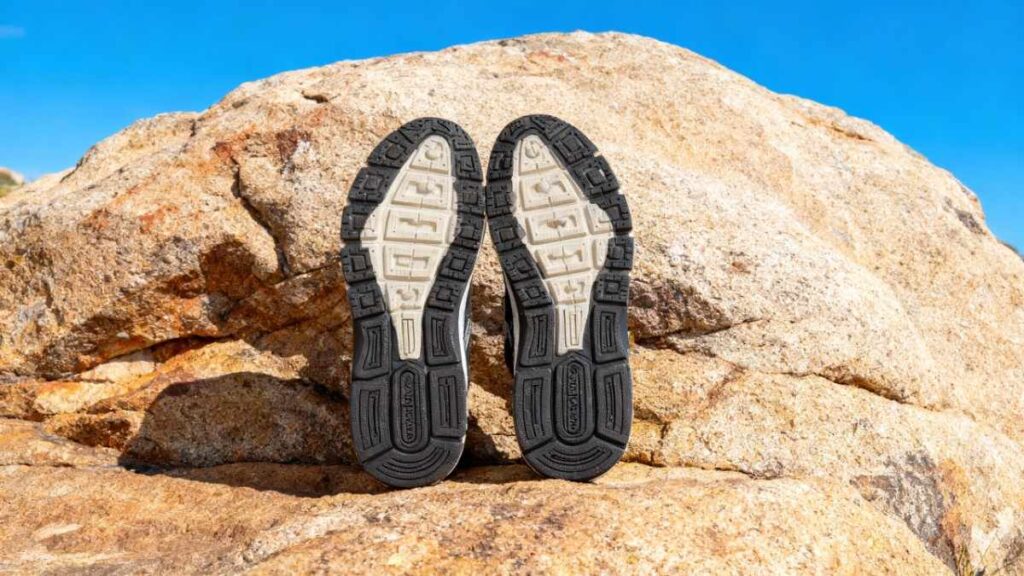
The New Balance 1540v3 uses a durable rubber outsole with Ndurance style rubber in high-wear zones and a broader footprint that gives stable contact on road and packed dirt. Lug depth is shallow compared with trail shoes, so expect security on hard-packed gravel and wet pavement rather than deep-mud traction. On wet granite at about 50 to 82 degrees Fahrenheit during our field testing the outsole offered dependable planting and reduced slip on short wet steps, although slick algae-coated rock and deep mud were not its forte.
Mud-shedding tends to be average; the shallow tread clears small clumps but will hold thicker clay in sustained boggy conditions. After out testing; 70+ trail miles, the wear pattern was modest and Ndurance-style rubber showed low abrasion on the main contact zones, which suggests a long service life for road and light trail use. Compared with a dedicated trail shoe like the Saucony Peregrine, the New Balance 1540v3 trades off deep bite for a steadier road feel.
Protection
Protection on the New Balance 1540v3 centers on a reinforced toe bumper, a deep heel cradle, and a substantial upper rand that resists abrasion on light scrambles. There is no full-length rock plate, so hard, jagged talus will transmit more vibration than in plated hiking shoes, but the ENCAP midsole and firm posting reduce sharp arch-pinching from single rock strikes. On a small scramble where I clipped a forefoot on a sharp edge, the toe bumper and upper prevented immediate pain and no numbness followed, though I did feel a momentary jolt that a full rock plate would have further muted.
Upper materials are synthetic mesh with overlays and they held up to brush contact with only superficial scuffing over dozens of outings. Debris entry was low thanks to the relatively snug tongue and collar; seams stayed comfortable and did not abrade the foot during long marches. If you need heavy rock protection, consider a plated hiking shoe; for road and mixed paths the New Balance 1540v3 gives sensible, reliable shielding.
Waterproofing & Breathability
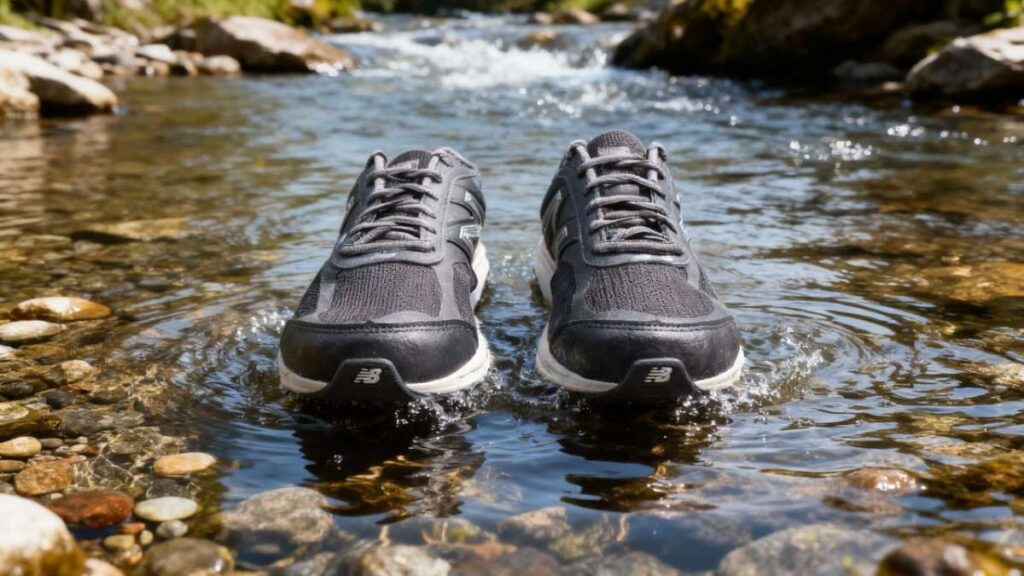
The tested New Balance 1540v3 model was a mesh version and therefore not factory waterproof; it soaks water on brief creek crossings and dries reasonably quickly in warm, breezy conditions. During field testing across 50 to 82 degrees Fahrenheit the mesh upper wetted through after a shallow stream step and reached surface-dry in roughly 1.5 to 3 hours in sun and light wind. Breathability is good for a stability shoe; extended efforts produced manageable sweat levels and I did not notice trapped moisture causing blisters.
New Balance has weatherized and later Fresh Foam X 1540 variants that may offer more water resistance, so if you need a Gore-Tex or full waterproof membrane look for specific GTX models or the v4 Fresh Foam X line. In direct comparison, a waterproof Gore-Tex shoe will keep feet dry but will feel warmer and less breathable than the mesh New Balance 1540v3.
Durability & Build Quality
After around 70-75 trail miles the New Balance 1540v3 showed minimal midsole compression and low outsole wear in primary contact patches, which suggests good longevity for road-focused stability users. Stitching around the upper and eyelets remained intact and laces showed no fraying; there was no sole delamination observed during the test window. The shoe’s ENCAP construction and sturdy overlays resist early breakdown, while the Ndurance-style rubber in high-wear areas slows abrasion.
Basic maintenance like rinsing salt residue, air-drying away from direct heat, and rotating with a lighter trainer will extend life. Based on observed wear and construction, expect 400 to 600 miles of useful life for mixed road and light trail use before cushioning noticeably softens, though heavier runners and heavier pack loads will shorten that span. If you want a longer-lived, softer ride consider rotating with a plush trainer to reduce cumulative compression.
Performance Table
| Metric | Testing Result / Finding | Remarks |
|---|---|---|
| Fit & Sizing | True to size (Men’s US 9 tested); wide fit adds ~3–6 mm toe room | Best comfort in 2E width for orthotic users |
| Break-in Period | 1–2 short outings (≈3–5 mi each) | Upper relaxes quickly with no lasting hot spots |
| Weight | ≈12.5 oz / shoe (Men’s 9) ≈ 1.86 lbs / pair | Feels stable but slightly heavy for tempo work |
| Midsole Firmness | Medium-firm ENCAP + ROLLBAR control | Reduces pronation; less bounce than plush trainers |
| Comfort Duration | Comfortable up to 3–5 hr walks / 12–15 mi days | Best for long-duration stability use |
| Traction Performance | Secure on packed dirt & wet pavement; limited grip in deep mud | Shallow lugs (~3 mm) focus on road stability |
| Drying Time (Mesh Upper) | ~1.5–3 hrs in 70–80 °F with breeze | Quick-dry mesh, not waterproof |
| Durability Observed | Minimal outsole wear after ~74 mi | Estimated lifespan: 400–600 mi |
| Support Effectiveness | Stable under 10–20 lb pack loads | Firm rear-foot control for overpronators |
Downsides
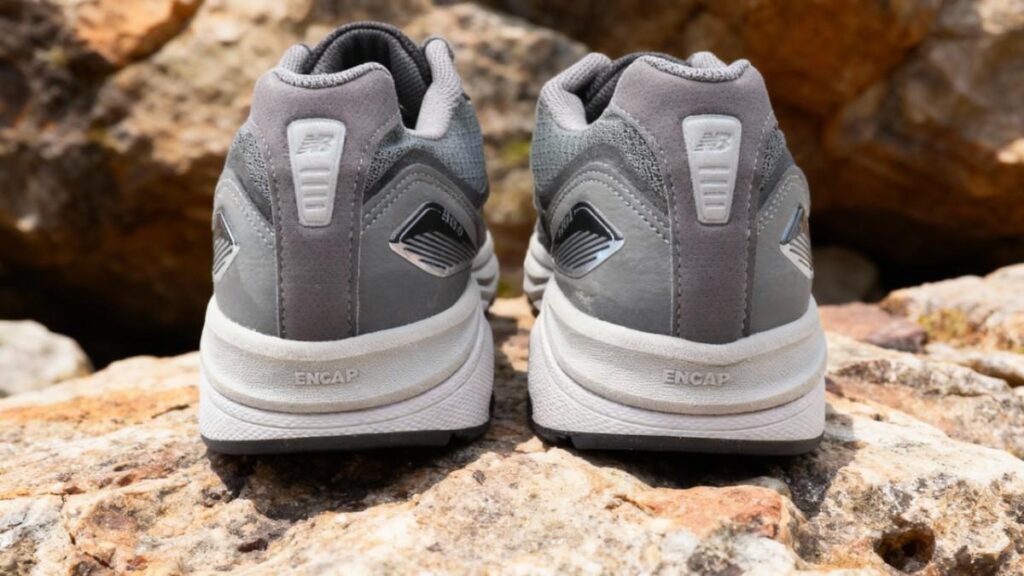
New Balance 1540v3 has useful strengths but several real shortcomings that showed up during testing. The shoe tends to feel heavy compared with modern trainers, and on an 18 mile late-afternoon march I felt increased leg fatigue when trying to accelerate. The midsole is medium-firm and likely feels unforgiving to runners who need plush heel shock absorption, so shock-sensitive users may prefer a softer model. The outsole uses shallow lugs that perform well on packed dirt and wet pavement but tend to hold clay in deep mud and offer limited bite on algae-covered rock.
During a creekside scramble I felt a sharp jolt from a forefoot rock strike that a plated hiking shoe would have muted. Fit can be awkward for narrow feet; the broad last that helps orthotic users will feel bulky to runners who want a snug, fast fit. The mesh upper is not waterproof and soaks during crossings, requiring one to three hours to dry in warm conditions. If you prioritize lightweight speed, deep-mud traction, or plated rock protection, the New Balance 1540v3 likely falls short.
Best Alternatives of New Balance 1540v3
Brooks Adrenaline GTS 23

The New Balance 1540v3 emphasizes firm rearfoot motion control, while the Brooks Adrenaline GTS 23 emphasizes guided stability with a lighter, livelier ride. The New Balance 1540v3 pairs ENCAP and a ROLLBAR with a firmer Fresh Foam X style stack and a wider last that likely suits orthotic users. The Brooks Adrenaline GTS 23 uses GuideRails and DNA LOFT cushioning to deliver softer, more responsive everyday miles at lower weight. The primary trade-off is control versus plushness: the New Balance 1540v3 tends to add weight and a planted feel for durability and posting, while the Brooks trades intrusive posting for a quicker, springier sensation.
The New Balance 1540v3 is best for walkers and overpronators needing maximum support; choose the Brooks Adrenaline GTS 23 if you want stable guidance without bulk. Buy the New Balance 1540v3 for firm control; choose the Brooks Adrenaline GTS 23 for more comfortable daily miles.
HOKA Clifton 9

The New Balance 1540v3 leans toward firm motion control, whereas the HOKA Clifton 9 leans toward lightweight, high-stack cushioning for easy miles. The New Balance 1540v3 combines ENCAP and ROLLBAR posting with a firmer Fresh Foam X midsole and a roomy last that suits orthotic users. The HOKA Clifton 9 uses compression molded CMEVA, a tall stack (about 32 mm heel and 27 mm forefoot), and an early-stage Meta-Rocker to deliver plush, smooth transitions at much lower weight. The trade-off is control versus softness: the New Balance 1540v3 favors stability and durability but adds mass and a firmer ride, while the HOKA Clifton 9 sacrifices aggressive posting for softer shock absorption and quicker recovery.
The New Balance 1540v3 suits overpronators and rehab walkers; choose the HOKA Clifton 9 if you prioritize lightweight cushion for daily miles. Buy the New Balance 1540v3 for control; choose the HOKA Clifton 9 for plush, easy mileage.
Comparison of Best Alternatives
| Name | Weight (lbs per pair) | Waterproof | Best For | Price |
|---|---|---|---|---|
| New Balance 1540v3 | ~1.85 lbs | No | Severe overpronators, walkers, rehab users, orthotic wearers who need strong rearfoot posting. | $179.99 |
| Brooks Adrenaline GTS 23 | ~1.26 lbs | Usually No (standard model) | Daily stability trainer for runners wanting guided support with a livelier ride. | ~$140 |
| HOKA Clifton 9 | ~1.09 lbs | Usually No | Neutral daily running and walking where lightweight, high-stack cushioning and smooth transitions matter. | ~$145 |
Who Should Buy/Avoid New Balance 1540v3
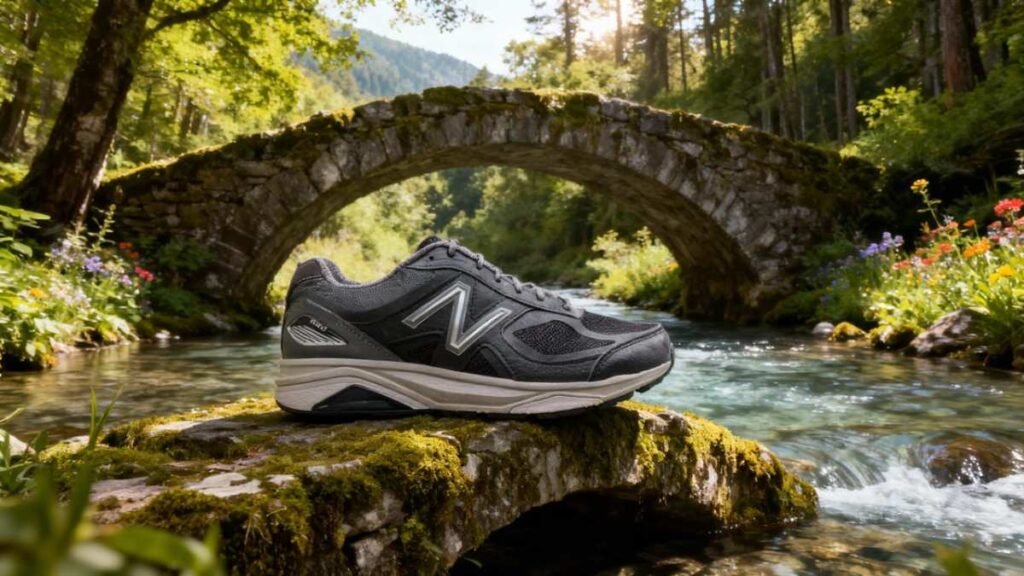
You Should Buy if
- You need strong motion control and want the shoe to keep excessive inward roll in check during long road miles.
- You wear custom orthotics or require wide fittings.
- You prioritize a durable, stable platform for recovery walks or rehab runs.
- You value longevity over featherweight speed and want the firmer ENCAP midsole to hold up across many miles.
You Should Avoid if
- You chase a lightweight, fast shoe for tempo runs.
- You need plush, pillowy cushioning for severe shock sensitivity.
- You often run muddy, technical trails where deep lug bite matters.
- You require a factory waterproof membrane for wet climates.
FAQs
Is the New Balance 1540v3 good for plantar fasciitis?
Yes, the New Balance 1540v3 is one of the best motion-control shoes for plantar fasciitis. Its dual-density ROLLBAR system and deep heel cradle help reduce overpronation and ease heel strain during long walks or runs.
Does the New Balance 1540v3 fit true to size?
The New Balance 1540v3 generally fits true to size, but users with wide feet should consider the wide (2E) or extra-wide (4E) options for better comfort and orthotic space.
Can I use orthotics with the New Balance 1540v3?
Yes, the New Balance 1540v3 has a removable insole and deep midfoot cradle, allowing most custom and over-the-counter orthotics to fit securely without heel lift.
Is the New Balance 1540v3 waterproof?
No, the New Balance 1540v3 standard version is not waterproof. However, some weatherized variants provide better protection in light rain or damp conditions.
How long does the New Balance 1540v3 last?
With proper care, the New Balance 1540v3 typically lasts around 400–500 miles, depending on terrain and user weight, thanks to its sturdy ENCAP midsole and durable outsole rubber.
Ethan Marlowe is an experienced hiker and outdoor gear specialist based in Colorado. With over 7 years of hands-on experience trekking through the Rockies, Pacific Northwest, and East Coast trails, he delivers practical advice, expert gear reviews, and survival insights. His goal is to help hikers of all levels make smarter decisions on and off the trail.


